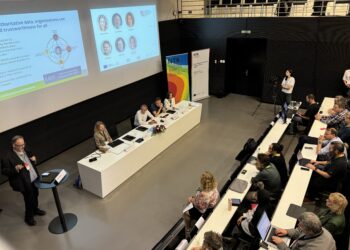Amidst the politics of open access, the financial pressure on research libraries, and the sense that ubiquity trumps quality, it is worth remembering that nothing can squash the fervor of academic endeavor. I was reminded of this at the recent European Congress of Mathematics in Berlin. It was a well-attended conference, diverse in age, gender, nationality and field. In addition to the math, there were a range of cultural aspects to the congress that made this conference stand out. The culture of math was represented in a variety of media from art exhibits to film. It reminded me that there is power in using different types of media to provide insight into cultural and historical aspects of a field. Books and journal articles are, of course, the currency of academic research, but there is a place for other forms of media, especially their role in enhancing the understanding of a field in a cultural setting.
A number of events that highlighted the impact of art and media were on display last week in Berlin. I attended a fascinating opening ceremony to an exhibit entitled Transcending Tradition: Jewish Mathematicians in German-Speaking Academic Culture. The remarkable stories of German mathematicians who contributed so much to the field are told through the era of the Weimar Republic, progressing into the dark era of Nazi terror – come 1933 there were no Jewish mathematicians left holding a university department chair in Germany. The exhibition is on right now at the Jewish Museum in Berlin, in itself a remarkable building designed by Daniel Libeskind.
The power of video was also on display in Berlin. Video is increasingly deployed in the publishing of academic research. Just look at the example of Research Square and their successful approach to developing academic article video summaries. In Berlin this last week one of the highlights was the presentation of a new movie by Ekaterina Eremenko. Ekaterina has directed a new full length movie that provides a fabulously human and touchingly entertaining look at how mathematicians work.
The movie, entitled The Discrete Charm of Geometry, is a story – a real story. It follows a team of some of the major mathematical minds of our time as together they tackle a major mathematical research question. These are researchers who assemble from various parts of the world, collaborating across language and cultural barriers. You gain an understanding of the mathematical problem itself – which is hard, as mathematics, perhaps unlike cancer research, or research into the origins of the Earth, or climate change can be quite abstract and difficult to get your head around. In this movie we follow a team of mathematicians exploring a mathematical question of discretization. What does this mean? Well, essentially the question is how can you make continuous objects from basic building blocks? Not only is this important as a mathematical question, but in thinking through this problem, you can address problems in the tangible world, architecture for example. In fact the facades of the pavilions at the Eiffel Tower in Paris are based on designs that are essentially rooted in discretization – a geometric approach to life. This theme of how fragments come together threads through the movie, not just in the research, but in the lives of the protagonists.
As you watch this movie you gain a clear grasp of what mathematicians do – how they think – how they discuss ideas – how they resolve conflict, and their joy in experiencing the beauty of ideas and solutions. The movie shows how mathematicians love their work, with displays of confidence, expressions of humility and ultimately the curse of self-doubt. In such a cerebral field, it is easy to ask “…am I good enough to truly make a difference?” The film is so human, showing how these researchers blend their personal lives and the constant presence of math — perhaps you are a slow thinker, or a fast thinker. Perhaps your idea is going to provide the answer, but how do you prove it?
If you are to watch one movie this year, perhaps this should be it. Publishers, librarians, funders, academics from a range of fields do not often take the time to realize that a field’s culture is important to understand as fully as is possible. If we do this, we will publish in a way that truly serves the needs of our researchers and educators — the value of publishing will be clear.
If you want to see the movie in person, those in New York will have their chance as there will be a screening at the Museum of Mathematics in Manhattan on the 11th of August with Ekaterina Eremenko, and mathematician and head of the Mathematics and Physical Sciences Division of the Simons Foundation, Yuri Tschinkel introducing the movie and engaging in discussion. The movie will likely be on general release soon after, but until then taste the sample in the trailer included above.
Discussion
1 Thought on "The Discrete Charm of Geometry – A Review"
Hi Robert: The Journal of Number Theory pioneered the use of “video abstracts” 8 years ago which we also put on YouTube. Please see https://www.youtube.com/user/JournalNumberTheory . Many of these have been seen thousands of times….



